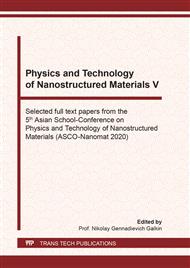[1]
A. I. Carim, S. M. Collins, J. M. Foley, S. Maldonado, Benchtop Electrochemical Liquid–Liquid–Solid Growth of Nanostructured Crystalline Germanium, J. Am. Chem. Soc. 133 (2011) 13292-13295.
DOI: 10.1021/ja205299w
Google Scholar
[2]
E. Fahrenkrug, S. Maldonado, Electrochemical Liquid–Liquid–Solid (ec-LLS) Crystal Growth: A Low-Temperature Strategy for Covalent Semiconductor Crystal Growth, Acc. Chem. Res. 48 (2015), 1881–1890.
DOI: 10.1021/acs.accounts.5b00158
Google Scholar
[3]
L. Ma, E. Fahrenkrug, E. Gerber, A. J. Crowe, F. Venable, B. M. Bartlett, S. Maldonado, High-Performance Polycrystalline Ge Microwire Film Anodes for Li Ion Batteries, ACS Energy Letters 2 (2016) 238–243.
DOI: 10.1021/acsenergylett.6b00615
Google Scholar
[4]
I. M. Gavrilin, V. A. Smolyaninov, A. A. Dronov, S. A. Gavrilov, A. Yu. Trifonov, T. L. Kulova, A. A. Kuz'mina, A. M. Skundin, Study of the Process of Reversible Insertion of Lithium into Nanostructured Materials Based on Germanium, Russian Journal of Electrochemistry 54 (2018) 1111-1116.
DOI: 10.1134/s1023193518120054
Google Scholar
[5]
I. M. Gavrilin, , V. A. Smolyaninov, A. A. Dronov, S.A. Gavrilov, A. Yu. Trifonov, T. L. Kulova, A. A. Kuz'mina, A. M. Skundin, Electrochemical insertion of sodium into nanostructured materials based on germanium, Mendeleev Communications 28 (2018) 659-660.
DOI: 10.1016/j.mencom.2018.11.034
Google Scholar
[6]
X. Liang, Y. G. Kim, D. K. Gebergziabiher, J. L. Stickney, Aqueous Electrodeposition of Ge Monolayers, Langmuir 26 (2010) 2877–2884.
DOI: 10.1021/la902929j
Google Scholar
[7]
V. Schmidt, U. Gösele, MATERIALS SCIENCE: How Nanowires Grow, Science 316 (2007) 698-699.
DOI: 10.1126/science.1142951
Google Scholar
[8]
D. G. Gromov, S. A. Gavrilov. Heterogeneous Melting in Low-Dimensional Systems and Accompanying Surface Effects, in: J. C. M. Piraján, Thermodynamics - Physical Chemistry of Aqueous Systems, InTech Open Access Publisher, UK, 2011, pp.156-190.
DOI: 10.5772/21429
Google Scholar
[9]
J. Gu, S. M. Collins, A. I. Carim, X. Hao, B. M. Bartlett, S. Maldonado, Template-Free Preparation of Crystalline Ge Nanowire Film Electrodes via an Electrochemical Liquid–Liquid–Solid Process in Water at Ambient Pressure and Temperature for Energy Storage, NanoLett. 12 (2012) 4617-4623.
DOI: 10.1021/nl301912f
Google Scholar
[10]
I. M.Gavrilin, D. G. Gromov, A. A. Dronov, S. V. Dubkov, R. L. Volkov, A. Yu. Trifonov, N. I. Borgardt, and S. A. Gavrilov, Effect of electrolyte temperature on the cathodic deposition of Ge nanowires on in and Sn particles in aqueous solutions, Semiconductors 51 (2017) 1067-1071.
DOI: 10.1134/s1063782617080115
Google Scholar


